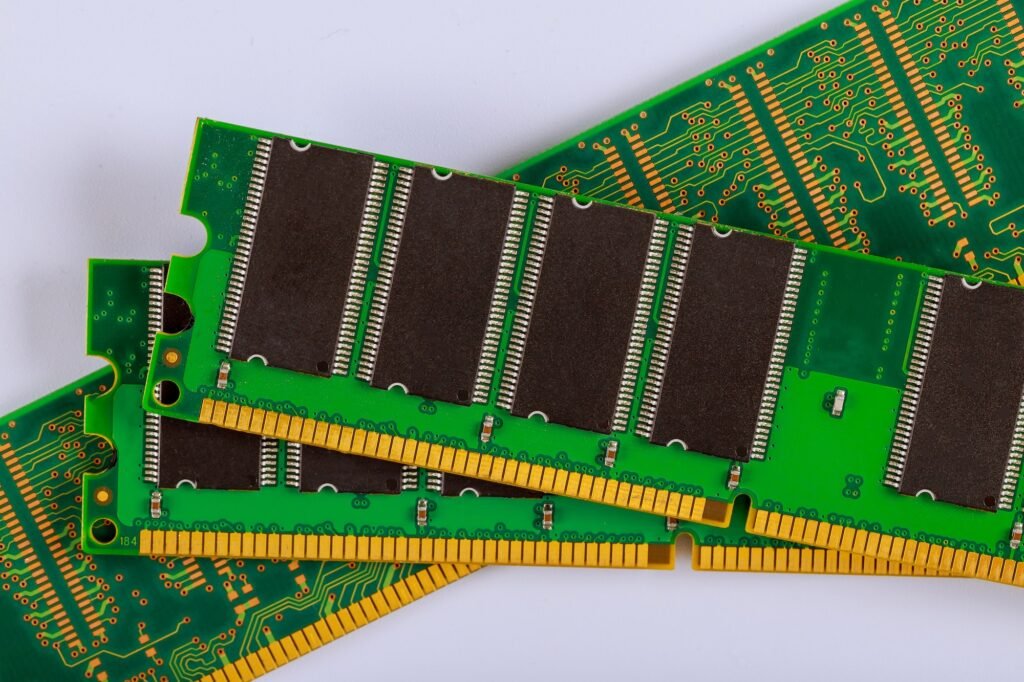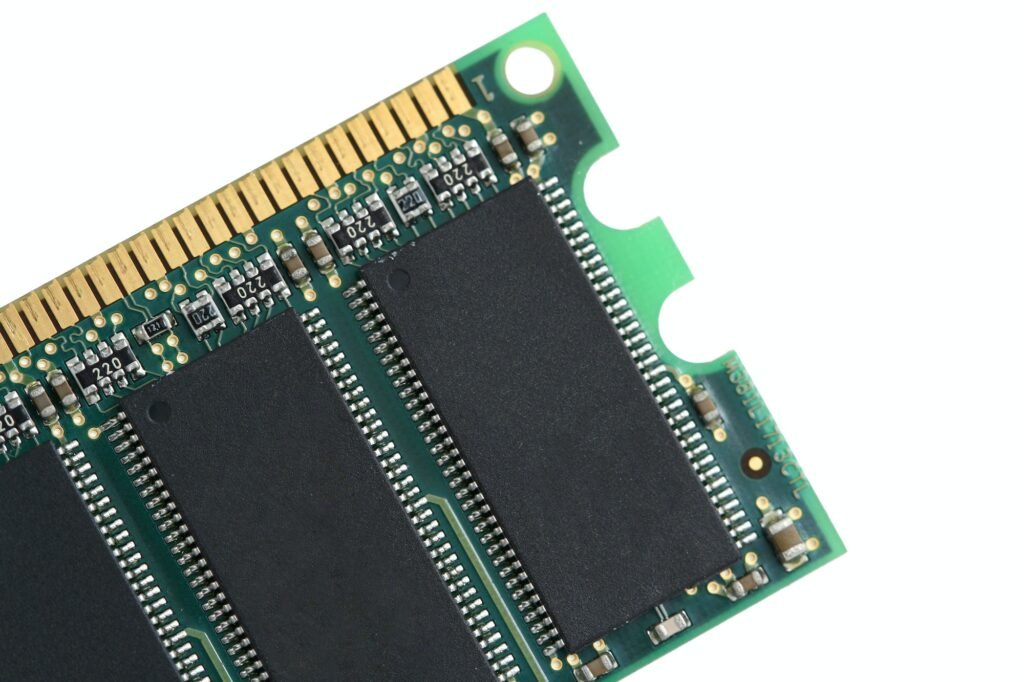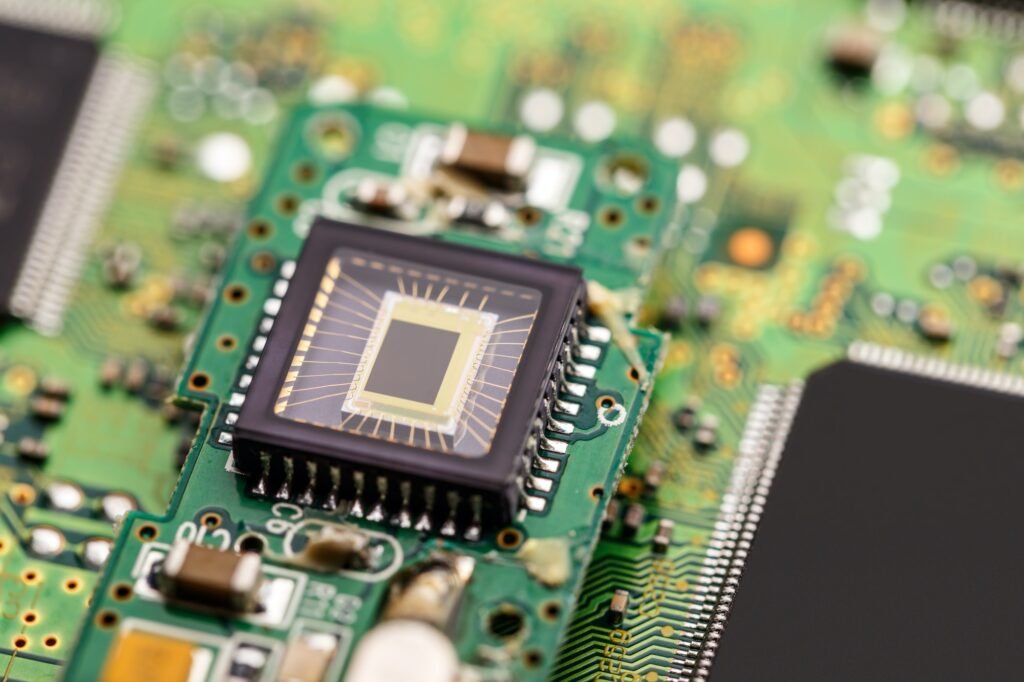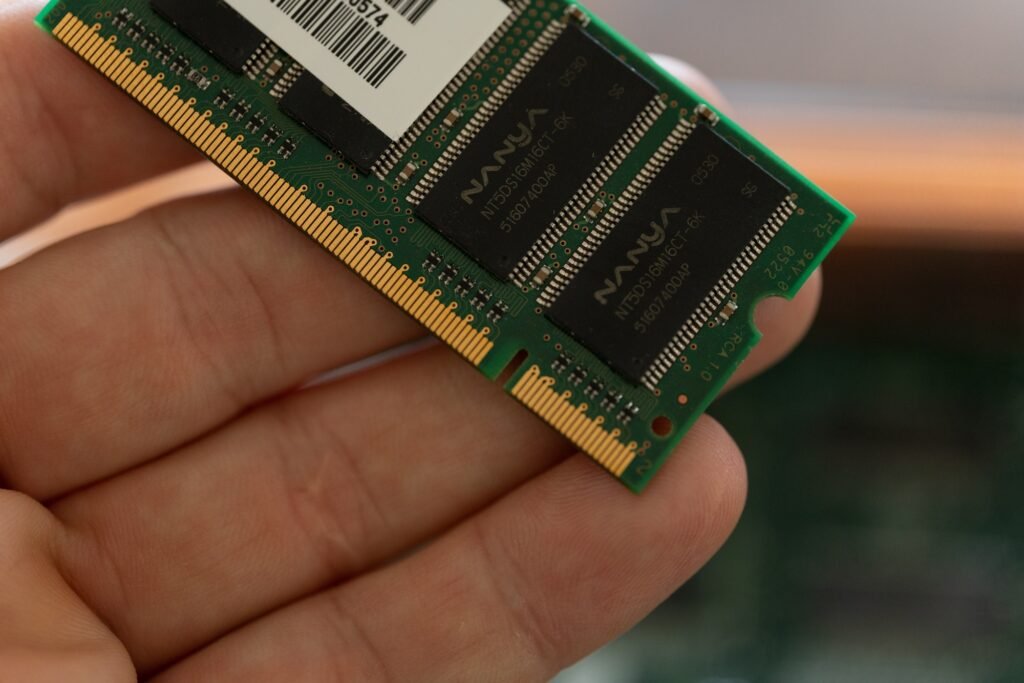Welcome to the fascinating world of memory chips! These small yet critical components have transformed our lives, playing a vital role in everything from smartphones to advanced aerospace systems. As we delve into the history, types, key players, and applications of memory chips, you’ll gain a deeper appreciation for their impact and potential in various industries.
Short Summary
- The memory chip industry has seen dramatic advancements over the years, with different types of chips for various applications.
- Major players in the memory chip manufacturing industry include TSM, Intel, Qualcomm and Broadcom. Memory chips are used in a variety of industries from consumer electronics to medical devices and aerospace/defense.
- Innovations such as personalized chips and phase-change technology have driven growth while challenges like cost remain. Selecting the right type requires careful consideration of factors such as form factor & read/write speed.
The Evolution of Memory Chips

Memory chips, or integrated circuits comprised of millions of semiconductors, have come a long way since their inception. These chips store data or execute code in electronic devices, making them indispensable in our digital world.
The journey of computer memory technology began with:
- Magnetic core memory
- Static RAM
- Dynamic random access memory (DRAM)
- NAND Flash memory
Companies like Micron (Crucial), Samsung, and Hynix produce dram chips, ensuring high-quality DRAM chip production.
As the demand for higher performance and storage grew, the memory chips industry adapted, developing innovative solutions to cater to the ever-changing landscape of technology.
Types of Memory Chips: DRAM vs. NAND Flash

At the heart of memory chip technology are two primary types: DRAM and NAND Flash, both essential storage solutions for embedded systems. While DRAM memory modules are commonly used in computers and servers for data storage and processing, NAND Flash memory cards find their place in portable devices and data storage applications.
Let’s dive deeper into these two types of memory chips and understand their unique characteristics and applications.
DRAM Memory Modules
As the backbone of computer memory, DRAM memory modules store data temporarily and enable quick access to programs and applications. They are used in a wide range of applications, from consumer electronics to industrial and automotive systems, as well as enterprise-level memory systems. Major players in the DRAM market include Samsung, SK Hynix, Micron Technology, and Kingston Technology.
However, the DRAM manufacturing landscape is not without challenges. The increasing cost of raw materials and the shrinking sizes of transistors within technology have made it imperative for manufacturers to invest in more sophisticated production methods to stay competitive.
When choosing the right DRAM memory module, consider factors such as the type of memory chip, the manufacturer, and the specific applications it is designed for.
NAND Flash Memory Cards
NAND. Flash memory cards are another type of memory chip that has made a significant impact on the world of electronics. These integrated circuits offer rapid read and write speeds, ample capacity, and non-volatile storage, making them ideal for portable devices like mobile phones, digital cameras, and USB flash drives. Available in various types such as SLC, MLC, TLC, and QLC, NAND Flash memory cards cater to a diverse range of applications, from consumer electronics to the automotive industry, and even healthcare and aerospace.
The versatility and reliability of NAND Flash memory cards have solidified their position as a key component in today’s fast-paced digital landscape, offering a broad range of storage solutions.
Key Players in Memory Chip Manufacturing

The memory chip manufacturing industry is dominated by several major players, including:
- Taiwan Semiconductor Manufacturing Co. Ltd. (TSM)
- Intel Corp. (INTC)
- Qualcomm Inc. (QCOM)
- Broadcom Inc. (AVGO)
- Nanya Technology
- SK Hynix Inc.
- Samsung
- Micron Technology
These companies have made significant contributions to the industry, driving innovation and shaping the future of memory chip technology.
Apart from the well-established giants, other notable manufacturers such as Apacer also play a crucial role in the memory chip market, competing with the top players and pushing the boundaries of what’s possible with memory chip technology. With such a diverse range of manufacturers, it’s crucial to research and understand their offerings when choosing memory chips to ensure compatibility, performance, and reliability.
Applications of Memory Chips in Today's World

Memory chips have found their way into a multitude of industries, revolutionizing how we store and access data. They are used in:
- Consumer electronics like smartphones and computers
- Automotive systems
- Medical devices
- Aerospace technologies
Memory chips play an integral role in various applications.
Let’s explore some of these industries in greater detail and understand the impact of memory chips on their operations and performance.
Consumer Electronics
In the realm of consumer electronics, memory chips are indispensable components in devices like:
- smartphones
- PCs
- wearables
- smart devices
They store and process data, allowing seamless access to programs, applications, and multimedia content. Manufacturers such as Kingston Technology and Infineon Technologies produce memory chips catering specifically to consumer electronics. Companies like these are continuously innovating to meet the growing demands of consumers for faster processing speeds, greater storage capacities, and improved energy efficiency in their electronic devices.
Automotive Industry
The automotive industry has embraced memory chip technology, with DRAM and NAND Flash memory chips being used for main storage applications such as engine management, infotainment, and navigation systems. These chips play a crucial role in enhancing vehicle performance and providing a seamless driving experience.
As the automotive industry moves towards greater connectivity and autonomous driving, the demand for memory chips with high processing power and storage capacity will continue to grow. This presents new opportunities for memory chip manufacturers to develop innovative solutions catering specifically to the needs of this rapidly evolving industry.
Medical Devices and Healthcare
Memory chips have made significant inroads into the medical devices and healthcare industry, enabling faster data processing, improved precision, and increased storage capabilities in equipment such as monitoring devices, telehealth systems, and semiconductor-enabled machines like MRI scanners and pacemakers. Despite the numerous benefits, the use of memory chips in medical devices also presents challenges, such as the high cost associated with their implementation and the potential susceptibility to data corruption.
However, as technology advances, these challenges are being addressed, paving the way for even greater innovation and impact in the medical field.
Aerospace and Defense
In the aerospace and defense sectors, memory chips are vital components in advanced systems and technologies, such as:
- Data storage
- Sensors
- Security
- Artificial intelligence
- High-capacity/high-speed memory devices
These industries rely on memory chips for their ability to store and process large amounts of data quickly and efficiently.
With the increasing complexity of aerospace and defense systems, the demand for advanced memory chips with greater storage capacity, faster processing speeds, and enhanced security will continue to grow. This presents exciting opportunities for memory chip manufacturers to develop innovative solutions tailored to the unique requirements of these industries.
Innovations and Trends in Memory Chip Technology

The memory chip landscape is constantly evolving, with innovations such as personalized chips, single-type memory for both storage and computing, and emerging technologies like phase-change memory (PCM) leading the way. Additionally, advances in materials like graphene and 3D stacking of chips have enabled greater storage capacity and reduced power consumption.
These advancements, coupled with the increasing demand for higher performance and more efficient memory chips due to emerging technologies like 5G, AI, and the Internet of Things, are driving the growth of the memory chip industry. As new innovations continue to emerge, the future of memory chip technology looks brighter than ever.
Challenges and Future Outlook for Memory Chip Industry

Despite the many advancements in memory chip technology, the industry still faces significant challenges, such as the increasing cost of raw materials and the shrinking sizes of transistors. These obstacles have resulted in higher prices and the need for more sophisticated production methods to stay competitive.
Nevertheless, the future outlook for the memory chip industry remains optimistic. As new technologies and innovations continue to be developed, the industry’s growth is expected to accelerate, transforming the way we store and access data across various applications and industries.
How to Choose the Right Memory Chip for Your Needs

Selecting the right memory chip for your specific needs can be a daunting task. To make the best choice, consider the following factors:
- DDR generation
- Compatibility with motherboard and CPU
- Form factor
- Read/write speed
- Capacity
- Frequency/timing
It’s also important to understand the differences between the two primary types of memory chips: DRAM and NAND Flash. DRAM is a volatile memory chip that retains data temporarily, while NAND Flash is a non-volatile memory chip that stores data permanently.
By taking these factors into account, you can ensure that you choose the most suitable memory chip for your requirements, providing optimal performance and efficiency.
Summary
Memory chips have undoubtedly revolutionized the way we store and access data across a multitude of industries, from consumer electronics to aerospace and defense. As we’ve explored the history, types, key players, and applications of memory chips, it’s clear that their impact and potential are immense. With continuous innovations and a bright future outlook, memory chip technology will undoubtedly continue to shape our world in ways we can only imagine.
Frequently Asked Questions
What are the three types of memory chips?
Memory chips come in four varieties: RAM, ROM, CMOS, and flash. RAM stands for random access memory and ROM stands for read only memory, both of which are known as primary memory.
CMOS stands for complementary metal oxide semiconductor and is used to store system settings. Flash memory is a type of non-volatile memory that can be erased and repainted.
Why memory chips are used?
Memory chips are used to provide internal storage for programs and data within a computer system. They are connected to the system data bus via tri-state gates and can be used for both temporary or permanent storage.
Memory chips are an important component of any computer system, as they provide the necessary storage for programs and data. They are connected to the system data bus via tri-states.
Where is the memory chip in a computer?
The memory chip in a computer is mounted on the motherboard, typically consisting of several integrated circuit chips on a printed circuit board plugged into a slot.
These chips are responsible for storing data and instructions for the computer to use. They are also used to store information such as user preferences, settings, and other data. The memory chip is an essential component of any computer system.
What industries rely heavily on memory chip technology?
Memory chips are essential for various industries, including consumer electronics, automotive, medical devices and healthcare, and aerospace and defense.
What are the key players in the memory chip manufacturing industry?
The memory chip manufacturing industry is led by Samsung, SK Hynix, Micron Technology and Taiwan Semiconductor Manufacturing Co. Ltd. (TSM).

